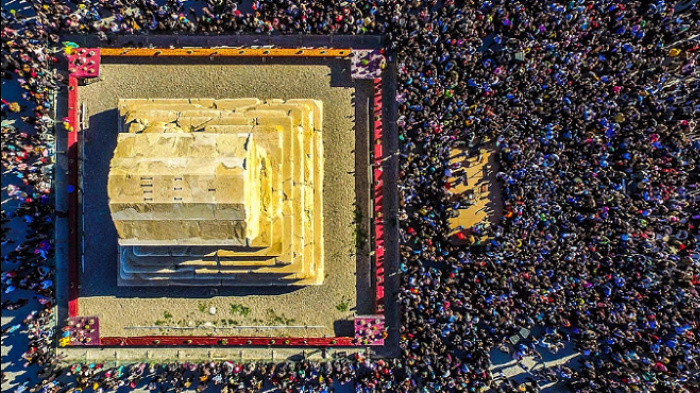Cyrus the Great and Rise of Nationalistic Fervor in Iran

(Visitors gather around the tomb of Cyrus the Great in Pasargadae to celebrate the new Persian Year of 1395. Source: Saeid Zanganeh/IRIB)
Thousands of Iranians gathered around the tomb of Cyrus the Great in Shiraz’s Pasargadae to celebrate the day commonly known as his birthday. The occasion, not inscribed in the country’s official calendar, has soared in popularity in recent years.
During the past months, copy of an official letter banning any tour to the Pasargadae circulated on the internet, probably provoking summons for the gathering. Videos of the gathering dominated Iran’s cyberspace Friday, showing attendants in various gestures, some knelt in prostration in front of the tomb, some others in crowd chanting slogans that mainly called for the revival of values from ancient Persia. A few even chanted what Principlist daily Sobhe No called monarchist slogans in support of the dethroned Pahlavi regime.
The revivalist movement has risen over the past decade, approximately thirty years since the Islamic Revolution ousted the Shah. The archaist nationalism was given a push in the Pahlavi era, during which Shah Mohammad Reza Pahlavi changed the origin of the calendar, using the beginning of Cyrus the Great’s reign as the first day, rather than the hijrah of Prophet Muhammad. With this came the 2,500th year of Foundation of Imperial State of Iran, celebrations in October 1971 on the anniversary of Cyrus’ coronation. Nation-wide celebrations that followed were meant to draw a parallel between the greatness of the past and the advancements of the new kingdom.
With the advent of the Islamic Revolution and the beginning of the Iraqi-imposed war, the tide of nationalistic fervor inclined toward ideological and Islamic values. However, the Iranian diaspora, mainly stuck in nostalgia from the Shah era, would spare no effort to keep the fire alive.
When Cyrus Cylinder toured its home Iran in 2010, President Ahmadinejad unveiled it below the Islamic Republic’s flag and honored a Cyrus impersonator by gifting him a keffiyeh, Arabic scarf worn by soldiers in the Iran-Iraq war and identified with the Basij volunteer militia of the IRGC. Ahmadinejad lauds the Cyrus Cylinder as the embodiment of human values and a cultural heritage for all humanity.
“The combination of current national symbols of the flag and keffiyeh with Cyrus the Great and his cylinder indicates a desire to create a holistic national identity, drawing upon both an ancient imperial legacy and a modern culture imbued with Islam”, Beeta Baghoolizadeh writes in Ajam Media Collective.
It was during Ahmadinejad’s presidential terms that an Iranian-Islamic identity and lifestyle became predominant in the official discourse. Many even saw the Supreme Leader’ insistence on an Iranian-Islamic lifestyle in the same line.
However, admiration of the glorious pre-Islamic Persia is thicker in the air than to be limited to Ahmadinejad and company. This very year, celebrities have once again joined the tides, with veteran actor Jamshid Masheyekhi on lead, as a short footage circulated of him, congratulating the occasion beside a small effigy of Pasargadae. A well-known TV host posted a photo of tomb with a caption quoting from Hegel saying world history starts from Cyrus. Alongside the picture goes a pilgrimage prayer, surprisingly in Arabic, fabricated by the presenter who also apologized for potential grammatical flaws.
Even the Instagram account of President Hassan Rouhani joined quite late in the evening, posting a photo of him in Persepolis, with a caption that called the monument a unique relic that shows Iran’s age-old civilization.
Despite a wide consensus on the significance of the era, a minority group of more historically aware Iranians disapproves the increasingly sacred halo around Cyrus and his reign, and the rumors and superstitions that go with them. They took to their accounts on social networks to ridicule yesterday’s gathering.
Nonetheless, for a number of Principlist observers the nationalistic revival of Pre-Islamic glory brings inherent problems for the modern-day Iran. The country’s unique demography necessitates an inclusive identity, which the nationalistic fervor has failed to take into account. One Principlist analyst the annual gathering in the tomb a national security threat, warning that fascist anti-Arab slogans chanted in such ceremonies could hurt the feelings of an indispensable Iranian ethnic group, Arab community mainly concentrated in southwestern Khuzestan Province, which in turn will jeopardize national solidarity. He predicted that the phenomenon could shift into a crisis in coming years.

